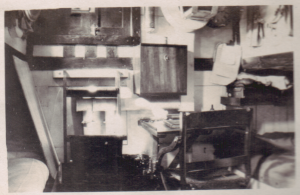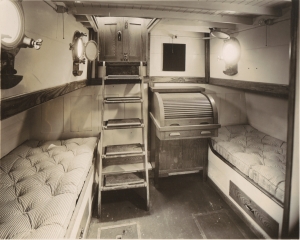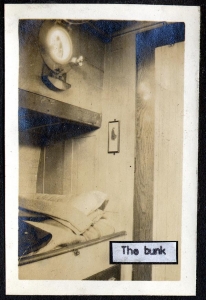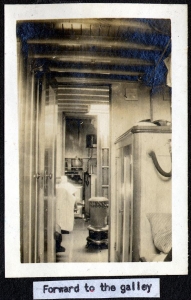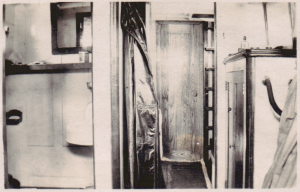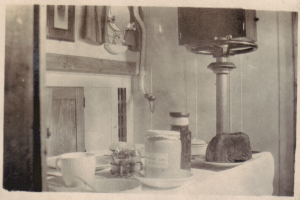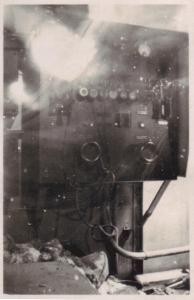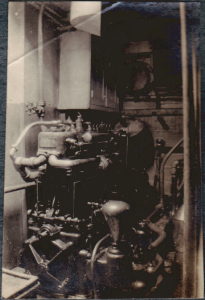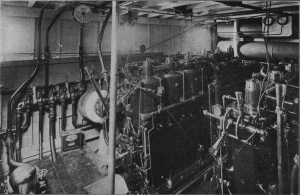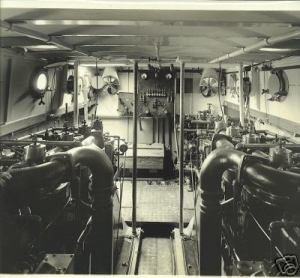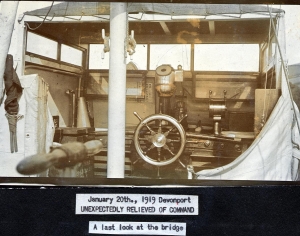Interior Arrangements
Thanks to the photo albums put together by Lieutenant John Hunter, RNVR and Lieutenant Russell Odell, RNVR we have some good interior photographs of their respective ML's. Laid out below is a sort of tour of the ML from aft to forward. We still don't have any images from the crew's quarters in the forecastle and are always looking for additional pictures to add detail to the overall interior view.
Starting aft in the officer's cabin we have two good, detailed images of the aft cabin showing the steps out of the officer's access hatch (to the left of the image) and a small writing desk (to the right). Note what appears to be a canvas screen protecting the foot of the starboard-side bunk from any water that might come in via the aft hatch. In the right-hand picture the electric lighting is clearly visible.
Thanks to the photo albums put together by Lieutenant John Hunter, RNVR and Lieutenant Russell Odell, RNVR we have some good interior photographs of their respective ML's. Laid out below is a sort of tour of the ML from aft to forward. We still don't have any images from the crew's quarters in the forecastle and are always looking for additional pictures to add detail to the overall interior view.
Starting aft in the officer's cabin we have two good, detailed images of the aft cabin showing the steps out of the officer's access hatch (to the left of the image) and a small writing desk (to the right). Note what appears to be a canvas screen protecting the foot of the starboard-side bunk from any water that might come in via the aft hatch. In the right-hand picture the electric lighting is clearly visible.
Another image from the after cabin shows the port-side bunk looking forward. The hatch to the officer's head is to the right of the picture. Note the drip pan beneath the overhead port hole. Also, the unpainted wood of the hatch and over the bunk.
We have two photographs looking forward from the officer's cabin along the passage to the officer's mess and the galley. Note in both photographs what appears to be a speaking tube hanging on the starboard-side locker. Also, in the wider image, note the interior of the officer's head with porcelain sink and mirror. The hatchway doors appear to have been varnished rather than painted though perhaps this varied from boat to boat.
We have two photographs looking forward from the officer's cabin along the passage to the officer's mess and the galley. Note in both photographs what appears to be a speaking tube hanging on the starboard-side locker. Also, in the wider image, note the interior of the officer's head with porcelain sink and mirror. The hatchway doors appear to have been varnished rather than painted though perhaps this varied from boat to boat.
It is also interesting to note what appears to be a coal-fired space heater in the officer's mess—no central heat aboard an ML! One can look beyond the space heater into the galley with its three-burner stove. Both the mess and the galley had overhead hatches allowing direct access from deck. The ladder to the mess room hatch is visible to starboard.
We have a good description of the after part of the ML from Lieutenant Eric P Dawson, RNVR, who wrote about his life aboard the ML's in Pushing Water. He describes the accomodates thus:
We have a good description of the after part of the ML from Lieutenant Eric P Dawson, RNVR, who wrote about his life aboard the ML's in Pushing Water. He describes the accomodates thus:
"So this is where we live and have our being. For'ard are the crew's quarters where, with a marvellous economy of space, seven men live and sleep in twenty feet of space. The officer's quarters are about as grandly miniature, and are ambitiously divided into a "Ward Room" where two can turn round and three becomes a crush, while the after cabin is spacious enough for two, provided one makes room for the other by remaining pressed tight against the side in his bunk."
Dawson provides an insight into the ML galley (and dining) as well:
"Crushed in somewhere amidships between the engine room and the gloriously named ward room is the galley, taking a space of about four feet athwartship.
"Sing me a song of the M.L. Cook-
May the Lord have mercy upon us-
With a petrol stove in a greasy nook-
May the Lord have mercy upon us!
Our meals a lukewarm lingering death-
We'll praise the Hun with our final breath
If he'll strafe our galley and slay our chef-
May the Lord have mercy upon us!"
May the Lord have mercy upon us-
With a petrol stove in a greasy nook-
May the Lord have mercy upon us!
Our meals a lukewarm lingering death-
We'll praise the Hun with our final breath
If he'll strafe our galley and slay our chef-
May the Lord have mercy upon us!"
So wrote the poet of the Movies [perhaps a reference to Gordon Maxwell - JC] of the galley, our sink-hole of strange and weird stenches that carry their message of strange forms of nutrition fore and aft, and permeate the nostrils of all hands, and especially of the cook."
Note the speaking tube in the corner of the officer's mess. Of great interest in this image is the large "valve-handle like" device just forward of the mess table. This is the head of a C-Tube type hydrophone and it's presence here indicates that the mess room also doubled as the listening room when an ML so equipped was hunting U-Boats. Under the handle is a graduated dial used to indicate the bearing of the tee (which is under the boat). The operator's head-set would be plugged into the top of the hand wheel. Presumably this is a shot of the tube in the "up" position. (Thanks to Todd Woofenden for spotting and explaining this.) More pictures of the C-Tube details may be found at the SubChaser Archives site.
The engine room was accessible only via an overhead hatch in the deck located aft of the deck pump along the centerline of the boat. The electrical panel—serving what was probably a very rudimentary electrical system for running lights, interior lighting and, on some ML's, powering things like hydrophones, a wireless, etc.—is located on the port side aft engine room bulkhead. The starboard rear quarter of the engine room was the location for the auxiliary engine and generator. Also served by the auxiliary was a ram-style water pump providing sufficient pressure for a firehose and, perhaps, to act as a bilge pump.
We have one photograph of an ML engine room, found in an early Elco publication The British M.L.s from about 1919. This image, looking forward and to port, clearly shows the two Standard engines, what may be the throttle handles (they were shifted into reverse simply by stopping the engines and changing the direction in which they crankshaft revolved), and, to the extreme left, the water ram bulb of the auxliary engine in the aft corner of the engine room. Also note what may be a cooling water manifold along the port wall and, forward, the compressed air bottles used to start the engines. Finally, along the port wall near the overhead deck is the telegraph repeater communicating the desired engine settings from the bridge.
This was clearly in the (relatively) rudimentary stages of the use of theses sorts of engines in such a craft and they are obviously of a type that required much "hand-holding" in day-to-day operation.
This was clearly in the (relatively) rudimentary stages of the use of theses sorts of engines in such a craft and they are obviously of a type that required much "hand-holding" in day-to-day operation.
There is one known good photograph of the ML bridge as it looked during the war. Note that the bridge enclosure was very lightly built and often augmented by canvas. In this excellent photograph we can see numerous details—a speaking trumpet, signal flags (to the extreme left of the image), a brass speaking tube (next to the speaking trumpet), various recognition symbols pasted to the cabin interior, and, in the foreground, one of the handles of the deck-mounted manual bilge pump.
